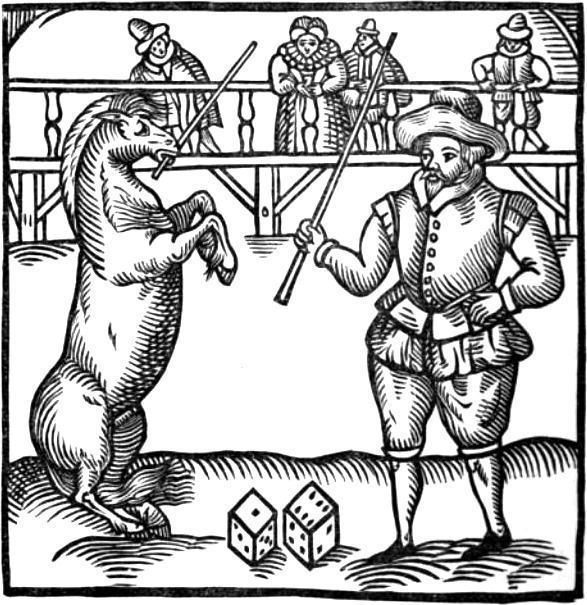Name William Banks | Role Showman | |
 | ||
William Banks (fl. 1588–1637) was a showman, who lived in England. His performing horse "Marocco" was central to his reputation as a performer.
Contents
In literature
Banks is identified in Tarlton's Jests (1600) as a performer who served the Earl of Essex and exhibited his horse. His feats, which are briefly described in an epigram in Bastard's Chrestoleros (1598), included counting money, mentioned by William Shakespeare (Love's Labour's Lost, i. 2, 1. 53), by Bishop Hall (Toothless Satyrs, 1597) and by Sir Kenelm Digby (Nature of Bodies, 1644, p. 321); singling out persons named by his master (Tarlton's Jests; Brathwaite's Strappado for the Divell, 1615); and dancing, with very frequent allusions made by the Elizabethan dramatists in relation to Banks' dancing ability.
At the end of 1595 a pamphlet appeared, of which only two copies now exist. Entitled Maroccus Extaticus, or Bankes Bay Horse in a Trance, the pamphlet contains a discourse between Banks and his horse. A woodcut represents Banks in the act of opening his show, and the horse standing on his hind legs, with a stick in his mouth and dice on the ground. From the title-page it appears that Banks was at the time exhibiting his horse at the Belsavage Inn without Ludgate, where such entertainments were frequent and where Banks charged twopence for admission to his performance (Brathwaite's Strappado). The dialogue of the pamphlet deals with the hypocrisy of the puritans and other alleged abuses. It promises a second part, which never appeared.
About 1600 the horse was reported to have performed his most famous but implausible exploit, which was to climb the steeple of St. Paul's Cathedral. In the Owles Almanacke (1618) it was stated that "since the dancing horse stood on the top of Powles, whilst a number of asses stood braying, below seventeen years". References to the event are to be found in many of Dekker's plays and prose tracts, in Rowley's Search for Money, etc. In 1601 Banks exhibited his horse in Paris; and an account of his show was given by Jean de Montlyard, Sieur de Melleray, in a note to a French translation of the Golden Ass of Apuleius (1602). The horse's age is there stated to be about twelve years. The magistrates of Paris suspected that his tricks were performed by magic, and for some time Banks was imprisoned and his horse impounded. But on his master declaring that he had carefully instructed Morocco by signs, they were both released, and Banks was permitted to continue his exhibition.
At Orleans, according to Thomas Higgons in his Direct Answer unto the Scandalous Exceptions of Theophilus Higgons, 1609 (p. 11), Banks was again suspected of witchcraft, and Banks, to calm suspicions, commanded his horse to seek out in the audience someone who had a crucifix on his hat; when done, have him kneel down unto it, and make him rise and kiss it. According to the same source, Banks visited Frankfurt shortly after.
In 1608 he returned to England, and was temporarily employed by Henry, Prince of Wales, to manage his horses (MS. Privy Purse Expenses, 1608–9). In succeeding years, according to references in the works of Ben Jonson, Sir Walter Raleigh (History of the World, 1614, i. 173), Michael Drayton, John Taylor, and Sir John Harington, Banks continued to give his shows in London. An elaborate account of these is given at the end of Gervase Markham's Cavelarice (1607).
Death
There are plenty of rumours regarding both Banks' and Morocco's deaths. According to playful allusions in Ben Jonson's Epigrams (1616) and in a marginal note to the mock romance of Don Zara del Fogo (1656), they were both burnt in Rome by the command of the pope. As a vintner, Banks was evidently alive in May 1637 (Ashmole MS. 826), and mention is made of "mine host Bankes" in Shirley's Ball, 1639. Curious allusions to Banks and his dancing horse are found as late as 1664 (Killigrew's Parson's Wedding).
Family
An early Lancashire pedigree states that a "daughter of Banks, who kept the horse with the admirable tricks", married John Hyde of Urmstone, a member of an ancient county family (Hunter's Illustrations to Shakespeare, i. 265).
